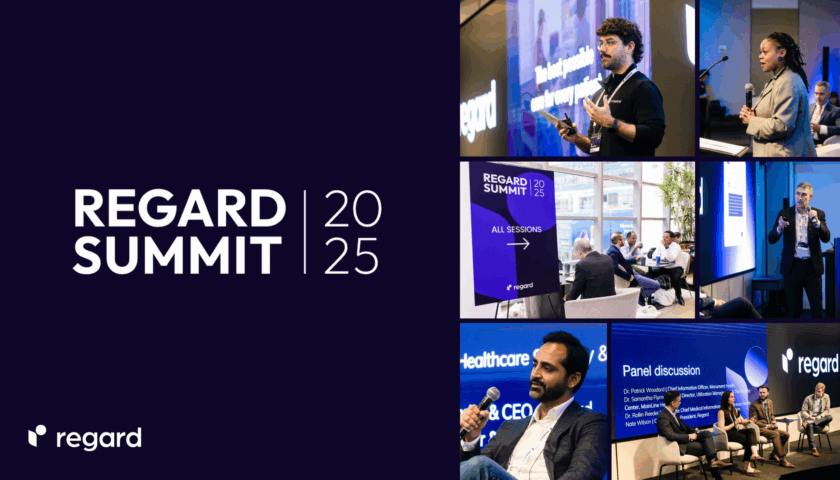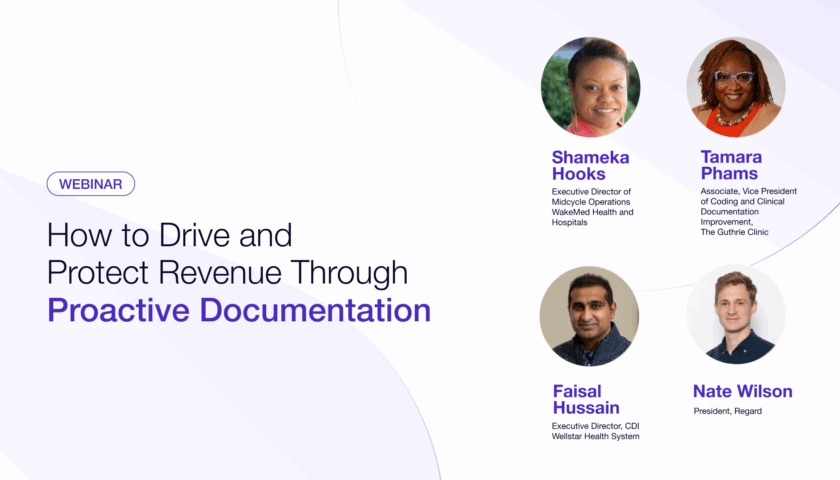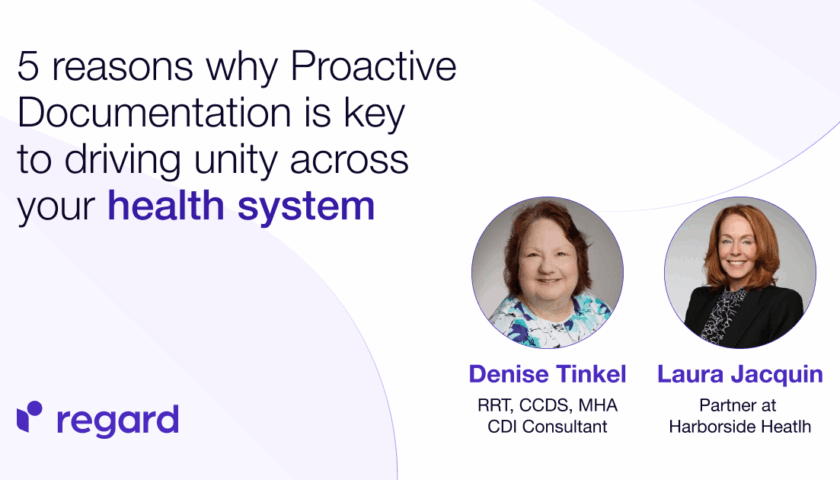
According to the American Medical Association, physicians are at higher risk for burnout than other US workers. More than 40% of doctors report symptoms of burnout, including emotional exhaustion, decreased sense of achievement, and depersonalization (lacking empathy or negative attitudes toward patients).
While the peak of burnout happened as a result of the COVID-19 pandemic, this dangerous trend is still a major problem––as physicians battle increasing time pressure in siloed and chaotic environments, hefty administrative burden, and rapidly evolving technology.
Regard aims to address the crisis of physician burnout with its Proactive Documentation solution that streamlines documentation while delivering key diagnostic insights that would otherwise be buried in voluminous patient files. To better understand how CDI can play a key role in enhancing physician quality of life, we sat down with the uniquely qualified Faisal Hussain, MD, MHIIM, RHIA, CCDS, CDIP, CCS, who is both a doctor and CDI executive.
We learned that by focusing on Proactive Documentation, modern tools, and collaborative strategies, CDI teams can significantly reduce physician workload, improve patient outcomes, and optimize revenue capture.
Meet the expert: Faisal Hussain, MD, MHIIM, RHIA, CCDS, CDIP, CCS, is the CDI executive director for Wellstar Health System of 11 hospitals and over 330 medical offices spanning cancer centers, rehabilitation centers, hospice facilities, and urgent care locations. He currently serves on the ACDIS Advisory Board and ACDIS CDI Leadership Council and regularly speaks at national and local ACDIS and AHIMA conferences and CDI and HIM podcasts.
These are the highlights of our conversation with Dr. Hussain, and his top recommendations for using the CDI function to reduce physician burnout and protect revenue:
What are the most significant contributors to physician burnout, as well as the downstream impacts on doctors, patients, and revenue?
It’s a loaded question because I moved outside bedside care and into the administrative space. I firmly believe that we need more physicians on this side to get their hands dirty and make things better.
Even though I’m in the admin space, I’m a physician advocate. I think a lot of non-physicians don’t really understand the kind of stresses the physicians are under. One of the biggest driving factors for me to move out of bedside care was the relentless lifestyle. I’d also had a knack for data, and when I started working with coding teams and understanding the impact of words and how that gets translated into these ICD-10 codes, I realized that the holy grail is to sanitize your data. That’s what got me excited about CDI, and I’ve been in this industry for over 11 years now.
With my clinical background, I have a unique perspective to connect the dots and look at the bigger picture, rather than having tunnel vision or a siloed approach. Truth be told, I speak with many physicians who don’t have any idea about all the administrative work that goes into keeping the doors open and the lights on.
On the other hand, when I’m in some administrative calls, they can’t empathize with the crazy lifestyle, burdens, or expectations that our healthcare system places on physicians. Documentation and coding is one piece of it, but there’s so much more that adds to this burnout.
A lot of physicians take work home on top of spending insane hours in the hospital or office, taking care of patients, and talking to caregivers. What they’re doing at home is documenting and charting. That shouldn’t be a thing.
There are also physicians who don’t take work home, and they are horrible documenters. To them, this is something that is not important. But in that case, are you doing enough for your patients? Is your chart really conveying the whole story? When they go to the next physician, that story is a very important part of the medical record.
Yes, reimbursement matters. Yes, the quality metrics driven by those codes are important, but at the end of the day, it should be telling the story of your patient so that the next physician or provider can easily follow along––and if you want to do it right, it is not easy.
What are the biggest barriers to CDI teams effectively addressing both physician burnout and revenue challenges?
There are so many coding guidelines that get under my skin. I cannot get my head wrapped around it, so there’s no way a physician who doesn’t know any of this can understand them. They also don’t understand that there is the inpatient side of coding, which is for the hospital billing (for our own reviews and E/M code selection). Those two systems don’t necessarily jive with each other, and that’s the crazy healthcare system we live in. A big source of frustration for physicians is selecting these codes without enough context.
If you talk to 100 physicians, 90 of them will tell you, “I just pick the first word that comes up.” Is that the best code? Probably not, but they’re not coders. They’re just trying to get through that requirement in order to get paid, then move on to the next patient. Their focus will always and should always be taking care of the patient, providing them good care, spending time with them, answering their questions, and working with caregivers.
Physicians sometimes see all administration as one. We’re all part of the machinery, keeping them from doing their work and taking care of patients. What helps is explaining how CDI actually impacts their work. Coding doesn’t impact their revenue, but it does impact their quality scores. It impacts the way their public profile looks. Once they understand, it’s like a light bulb goes off, and they start seeing CDI teams as allies rather than adversaries.
How can CDI teams leverage Proactive Documentation methodology to reduce the burden on physicians?
I think a lot of focus is put on the number of queries. Queries, in my opinion, should be a last resort. It’s a band-aid fix. Some of them may be legitimate to get better documentation on the medical record so you can have a true picture of the complexity of the patient. But that comes at a cost. It is adding to the work of the physician. The focus should be on how we get better documentation without the query.
I recently went to a conference called Vive in Nashville, and it blew my mind with all the technology that is available. It is now possible to do CDI proactively, rather than this reactionary query model that we have been stuck in for 15-20 years. We use AI when writing a text or email; I can write my initial thoughts and Copilot or ChatGPT can make it a lot better. Why not do the same for the physicians?
With Proactive Documentation, I can get that documentation right at the point of care. I have just seen the patient, and there’s no better time for getting the details of that encounter on paper. Regard uses AI to produce the first draft of a note by looking at all the clinical data, before the physician even sees the patient. Other technologies help record the patient-physician conversation. I am excited by both of these types of technologies. No need to bring the work home!
We’re moving away from reactionary queries. We will still need CDI teams who can do reviews, but they can go after more in-depth reviews. No more wasting time on the same queries that we were writing in 2005.
How can a tool like Regard help CDI teams foster a more collaborative relationship with physicians to improve documentation and coding accuracy?
The reason I like Regard is that CDI is a byproduct of use. It’s really a clinical decision support system. It helps because physicians carry so much information in their head: all the medical education and training, all the knowledge about the latest guidelines, all the patient data, previous medications, current medications, lab data––everything.
Doctors are constantly making so many decisions and that adds to the burnout. Where Regard shines is by putting all of that information in one place and presenting it in a very nicely packaged manner where it reduces the work that they would have to do otherwise. It automatically generates the documentation palatable for the ICD10 requirements for the coders.
As a CDI professional, it is a prerequisite to help physicians understand the importance of documentation and coding and to find tools that make this step easier for them. Otherwise there is no way you’re going to get any buy-in from them.
Step in their shoes to see how the tool will look from their perspective. I often feel a lot of CDI and the coding leaders don’t do that. They’re focused on what they’re doing, and at the end of the day they’re trying to make physicians, hospitals, and health systems look good. But if a physician has 30 patients to see during the day, it’s already 9pm. They don’t care about their ‘physician profile’ at that hour.
Have that empathy in design. Make workflows physician-friendly. Once they see physician wellbeing is being addressed, you will see a lot of physicians want to collaborate, because they too are trying to do the right thing.
Finally, physician revenue depends on the contract you have. They want to know how changes will impact them. If revenue concepts like CMI are already baked into their contracts, they take revenue seriously. If that is not the case, one thing I will tell you is that physicians always care about the quality of care and how it is perceived.
The lines are now blurred between pure revenue and quality because we’re moving towards what CMS calls ‘pay for performance.’ So if you do well and your data looks good, you are going to see the revenue benefits in return.


